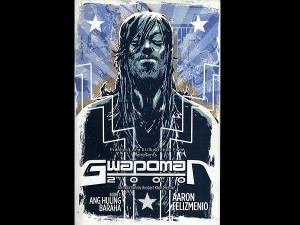
“Ang Huling Baraha” collects the first arc and the three released issues of Felizmenio’s independently-published limited series that ran from 2008 to 2012, boosted by the final, fourth issue, two prologues and an epilogue. The character made appearances in the “Bayan Knights” titles, but Felizmenio’s unusual hero really gets to strut his style in the mini series and thus, by extension, in this graphic novel.
The book doesn’t dwell too much on Gwapoman’s history, just stating that he has found himself in prison with the same brand of people he used to hunt down, and now he no longer wants to return to life on the other side. But there is a plan afoot, and he won’t get what he wants.
Gwapoman himself is a study in super-heroic irony. The book goes out of its way to state that Gwapoman isn’t good-looking at all, and the superhero doesn’t really act like one at all. Though he may look in passing like any of the generically “grim-and-gritty” superheroes born in the 1990s, Gwapoman isn’t one. Instead, he is an active self-loathing roughhouser with no superpowers, but armed with a grappling hook, a penchant for violence and pithy commentary. He really hates his superhero handle, saying he would have preferred the name “Wolverine,” which is, of course, already taken. That’s just another reality that Gwapoman will have to deal with.
Felizmenio makes Gwapoman a character who, despite appearances, is difficult to hate, because it’s clear that Gwapoman—real name Edgardo Liwayway—is doing what he can to make things better. The other irony is that Gwapoman himself doesn’t dominate his own book. It’s the young thief Alas who appears prominently as a possible target for Gwapoman to take down. But all is not what it seems, as Gwapoman is drawn into a conspiracy that involves a powerful enemy, a kidnapping and the revelation of Gwapoman’s connection to the mysterious junk shop owner known as Mang Tan. All that can be found here, as well as the titular character’s ongoing argument with himself.
The story is fairly complicated, with portions of it twisting into itself at different times. Felizmenio’s ambitious plot demands you pay serious attention or you may have to reread parts. “Ang Huling Baraha,” as you can see from the title, is almost exclusively told in dense Filipino, and the storytelling gets murky in some parts but never loses its edgy feel. Gwapoman’s narration and Alas’ comebacks make for both ironically deep and humorous reading, respectively.
Since the original mini series was published over a four-year period, Felizmenio’s skill has also evolved a lot over that time. The earlier issues of “Gwapoman 2000” have a scratchy, more line-oriented quality, but the panel art becomes extremely refined towards the last issue, becoming moody and more atmospheric with a more ink-washed feel. That aesthetic quality is reflected in the collected edition’s fantastic cover, also by Felizmenio.
All in all, this makes “Gwapoman 2000 Book 1: Ang Huling Baraha” a solid package showcasing the emergent, formidable talents of Aaron Felizmenio, who has now turned us into willing witnesses of whatever he does next, but we would love to see whatever happens after to the cunning cliffhanger which ends this book. You’ve made us believers, Gwapoman. Now, get back to work.
Aaron Felizmenio’s “Gwapoman 2000 Book 1: Ang Huling Baraha” is available in paperback from Comic Odyssey Galleria and Druid’s Keep at the Fort strip.

